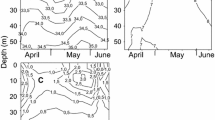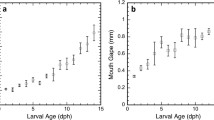Abstract
Patches of the neritic ctenophores Beroe ovata and Bolinopsis vitrea were observed on the edge of the Great Bahama Bank in order to determine the interaction between the predator Beroe ovata and its prey Bolinopsis vitrea. Laboratory experiments on Beroe ovata showed that it responds chemokinetically to the presence of its prey; as it swims it collides with other etenophores on which it preys. The unique use of macrocilia as cutting implements aids the predator in removing tissue from its prey, yielding maximum gain from each encounter. By means of direct observations while diving, data on horizontal and vertical patchiness, swimming speeds, abundance, and feeding behavior were collected, and used to assess the impact of populations of the predator on its prey. Together, these two animal populations form an ecological feed-back system which affects other portions of the planktonic community.
Similar content being viewed by others
Literature Cited
Arenberg, I. K., W. F. Marovitz and A. P. MacKenzie: Preparative techniques for the study of soft biological tissues in the scanning electron microscope. Trans. Am. Acad. Ophthal. Oto-lar. 75, 1333–1345 (1971).
Bigelow, H. B.: The ctenophores. Bull Mus. comp. Zool. Harv. 54 (12), 369–408 (1912).
Bishop, J. W.: Feeding rates of the ctenophore Mnemiopsis Chesapeake Sci. 8, 259–264 (1967).
Coonfield, B. R.: Regeneration in Mnemiopsis leidyi Agassiz. Biol. Bull. mar. biol. Lab., Woods Hole 71, 421–428 (1936).
DeCeccatty, M. P. and M. L. Hernandez: Integratio and symmetry in Beroe. Am. Zool. 5, 537–543 (1965).
Fraser, H. F.: The role of ctenophores and salps in zooplankton production and standing crop. Rapp. P.-v. Réun. Cons. perm. int. Explor. Mer 153, 121–123 (1962).
—: The ecology of the ctenophore Pleurobrachia pileus in Scottish waters. J. Cons. int. Explor. Mer. 33, 149–168 (1970).
Greve, W.: Cultivation experiments on North Sea ctenophores. Helgoländer wiss. Meeresunters. 20, 304–317 (1970).
—: Ökologische Untersuchungen an Pleurobrachia pileus. 1. Kreilanduntersuchungen. Helgoländer wiss. Meeresunters. 22, 303–325 (1971).
Horridge, G. A.: Macrocilia with numerous shafts from the lips of the ctenophore Beroe. Proc. R. Soc. (Ser. B.) 162,351–363 (1965).
Hyman, L. H.: The invertebrates: Protozoa through Ctenophora, 726 pp. New York: McGraw-Hill 1940.
Kamshilov, M. M.: Size of ctenophore Beroe cucumis Fabr. in relation to its feeding. Dokl. (Proc.) Acad. Sci. U.S.S.R. (Sect. Biol. Sci.) 131, 277–279 (1960a). [Transl. from Dokl. Akad. Nauk SSSR 131 (4), 957–960 (1960)].
—: Feeding of ctenophore Beroe cucumis Fabr. Dokl. (Proc.) Acad. Sci. U.S.S.R. (Sect. Biol. Sci.) 130 (1/6), 128–129 (1960 b). [Transl. from Dokl. Akad. Nauk SSSR 130 (5), 1138–1140 (1960)].
—: Biologiya grebnevikov pribrezh'ya Murmana. Trudy murmansk. morsk. biol. Inst. 3 (7), 36–49 (1961). [Abstr. Referat. Zh. biol., 1962, No. 16 (71),-Soviet Abstr. Biol.].
—, E. A. Zelikman i, M. I. Roukhiyainen: Plankton pribrezh'ya Murmana. In: Zakonomernosti skoplenii i migratsii promyslovykh ryb b priberezhnoi zone Murmana, pp 59–102. Moscow-Leningrad: Akad. Nauk SSSR. 1958. [Abstract in Referat. Zh. biol., 1960. No. 38526-Soviet Abstr. Biol.].
Lebour, M. V.: The food of plankton organisms. J. mar. biol. Ass. U.K. 12, 644–677 (1922).
—: The food of plankton organisms. J. mar. biol. Ass. U.K. 13, 70–92 (1923).
Marovitz, W. F., I. R. Arenberg and R. Thalmann: Evaluation of preparative techniques for the scanning electron microscope. Laryngoscope, St. Louis 80, 1680–1700 (1970).
Mayer, A. G.: Ctenophores of the Atlantic coast of North America. Publs Carnegie Instn 162, 1–58 (1912).
Nelson, T. C.: Occurrence and feeding habits of ctenophores in New Jersey coastal waters. Biol. Bull. mar. biol. Lab., Woods Hole 48, 92–111 (1925).
Parduez, B.: Ciliary movements and coordination in ciliates. Acta microbiol. hung. 1, 175–221 (1956).
Rauchbach, E. and I. K. Arenberg: Scanning electron microscopic observations of the cilia in the sensory epithelia of the inner ear of the lemon shark. Negaprion brevirostris. Anat. rec. 172, p. 390 (1972).
Smith, M. E. and E. Finke: Critical point drying of soft biological material for the scanning electron microscope. Invest. Ophthal. 11, 127–132 (1972).
Will, J. G. F.: Horae tergestinac. Beschreibung und Anatomie der im Herbste 1843 bei Trieste beobachteten Akalephen, Leipzig: Voss 1844.
Author information
Authors and Affiliations
Additional information
Communicated by J. Bunt, Miami
Rights and permissions
About this article
Cite this article
Swanberg, N. The feeding behavior of Beroe ovata . Marine Biology 24, 69–76 (1974). https://doi.org/10.1007/BF00402849
Accepted:
Issue Date:
DOI: https://doi.org/10.1007/BF00402849




